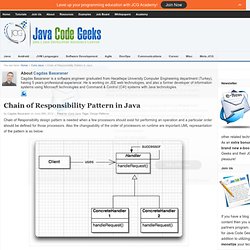Java
> Thefatih
This is my collection of websites for advanced level Java developers.

Those website provide news, answers to general questions or interview questions, great lectures, etc. Quality is the key factor of good websites. In my opinion, they all have the highest quality. In the following, I will also share how I use these websites for learning or for fun. You may think some sites are good for any level developers, but I think it is how they are used determines whether they are good sites for an advanced level Java developer. 1. Stackoverflow.com is probably the most popular website in the programming world. Another good thing about stackoverflow is that it is social. URL: 2. I would say this website is fun, lots of developers share their blog articles. URL:
GitHub’s 10,000 Most Popular Java Projects: Here are the Top Libraries They.
As Java developers working with a language that’s both mature yet highly evolving, we’re faced with a constant dilemma whenever we write new code – go with the hot new technology that everyone is talking about, or stick with a tried-and-true library?

Since a very large part of Java applications are commercial in nature, it can sometimes be hard to separate the buzz around a new framework with the number of projects actually putting it to use. This is important, as the community of users and contributors around a framework is one of the strongest factors in determining its continuous success and development. We decided to use a data-based approach to get more insight into this, by analyzing which Java projects developers are actually using on the world’s largest open repository for Java projects – GitHub. In our previous post we presented the main results of our GitHub research project and the top 100 libraries for JavaScript, Ruby and Java. The Approach The Results. Design Patterns in Java. 1.

Design pattern in software development Design patterns are proven solutions approaches to specific problems.
Design Patterns in Java. Chain of Responsibility Pattern in Java. Chain of Responsibility design pattern is needed when a few processors should exist for performing an operation and a particular order should be defined for those processors.

Also the changeability of the order of processors on runtime are important.UML represantation of the pattern is as below: Handler defines the general structure of processor objects. ‘HandleRequest’ here is the abstract processor method. Handler also has a reference of its own type, which represents the next handler.
What Is Java Design Patterns?
Observer Design Pattern in Java. ‘Don’t call us, we’ll call you’… that’s the Hollywood OO (Object Oriented) Principle and it’s exactly what the Observer pattern is about.

In this post we’ll review this pattern and how it is used in Java, you may already have used it without knowing… According to Head First Design Patterns book, this is the definition of the Observer pattern: Defines a one-to-many dependency between objects so that when one object changes state, all its dependents are notified and updated automatically. Sounds familiar?
Getting started with Spring Data Solr. Spring Data Solr is an extension to the Spring Data project which aims to simplify the usage of Apache Solr in Spring applications.

Please note that this is not an introduction into Spring (Data) or Solr. I assume you have at least some basic understanding of both technologies.
Functional Thinking for Java. A functional programming crash course for Java developers. (Page 1 of 2)Functional Programming dates all the way back to Lisp in the 1950s.

Imperative, procedural, and object-oriented programming each had their long runs as paradigms, but functional programming never quite broke through to the mainstream. But with Java 8’s support of lambda expressions, type inference, syntactic sugar for static methods, and new APIs like Stream and CompletableFuture, there is a renaissance around functional programming.
Java Abstract Class: In-Depth Tutorial to Using Abstract Class in Java. Abstract class in Java is a special type of class that contains abstract methods.

It’s a very useful concept in Object Oriented Programming in general and Java in particular. An abstract class isn’t very dissimilar to the English word, ‘abstract’, from which it derives its name, as we will learn below.
Tutorial of java programming with Apache Ant. Several Architectural Styles with Java EE 7. Several Architectural Styles with Java EE 7 Posted by agoncal on 29/10/2013 · 12 Comments If you are like me, in your career you came across Architects who want to homogenize every single application in the company : from the smallest web app to the biggest application.

All projects have to conform to the 542 pages In-house Architectural Guide and develop a 6 tier application (it could be 5, 6, 7 or 8 tiers, look like architects are paid by the tier). This is wrong. In fact, you should follow the good old saying : the right tool for the right job, or, the right architecture for the right project’s needs. Horizontal Services Style When JBoss Forge generates a JSF web application with a REST interface, both JSF backing beans and JAX-RS endpoints use the EntityManager to deal with JPA Entities. I call this Horizontal Services style because if you need to add a SOAP Web Service interface, you will write a BookSOAP which will also use an EntityManager and directly invoke the entities.
Java heap space – Everything you need to know.
In this tutorial we will discuss about Java’s heap space. To begin with, the Java Virtual Machine (JVM) is the execution component of the Java Runtime Environment (JRE) that executes the bytecode residing in a Java .class file. While executing an application, new objects are created. The heap space is where all new objects are stored, while the application is being executed by the JVM.
The 7 Log Management Tools Java Developers Should Know. Splunk vs.

Sumo Logic vs. LogStash vs. GrayLog vs. Loggly vs. PaperTrails vs. Splunk, Sumo Logic, LogStash, GrayLog, Loggly, PaperTrails – did I miss someone? To deal with the growth of log data a host of log management & analysis tools have been built over the last few years to help developers and operations make sense of the growing data. Splunk As the biggest tool in this space, I decided to put Splunk in a category of its own. Pros Splunk is probably the most feature rich solution in the space. Cons. Java vs. C#: Which Performs Better in the 'Real World'?
Let’s compare Java and C#, two programming languages with large numbers of ardent fans and equally virulent detractors.
Despite all the buzzing online (“I’m about to rant.
Sean's thoughts : Better Java. Java is one of the most popular programming languages around, but no one seems to enjoy using it. Well, Java is actually an alright programming language, and since Java 8 came out recently, I decided to compile a list of libraries, practices, and tools to make using Java better. This article is on Github. Feel free to contribute and add your own Java tips and best practices. Traditionally, Java was programmed in a very verbose enterprise JavaBean style. The new style is much cleaner, more correct, and easier on the eyes.
3 things Java developers should know. HOW TO: Stereotyping a java Class.
In this HowTo post I will show how we can stereotype a class with another class. Why is this useful? When there are a lot of BCI’ing happening in your project, it is not prudent to let every developer write the BCI code.For one, this does not abstract the BCI library used. Thus changing the library itself becomes difficult.BCI is complex. The probability of introducing bugs increase if every developer has to understand BCI.It would be better to write a framework that allows a developer to write an interface and a class which can be used for BCI’ing.Given that java does not support Multiple inheritance, stereotyping can be used to achieve Multiple inheritance without delegating.
Check here for multiple inheritance options.There exists aspects of code such as profiling that need to be present only if the code is being tested. StereoTyping means…
Implementing High Performance Parsers in Java. Note: This article is an updated version of a previous article on the same topic. The original version of the article was intended to capture some of the main points of creating a high-performance parser, but it received some criticism from readers for the perception that other parts were overlooked. The original article was completely revised and a more complete version of the associated code was created.
We hope you enjoy this revision.
Sequential and binary search implemented in Java. Java EE: The Basics. Wanted to go through some of the basic tenets, the technical terminology related to Java EE. For many people, Java EE/J2EE still mean Servlets, JSPs or maybe Struts at best. No offence or pun intended!
Understanding JVM Internals, from Basic Structure to Java SE 7 Features. The contentof this article was originally written by Se Hoon Park on the Cubrid blog.
Understanding JVM Internals. Reactive Programming Patterns in Akka using Java 8. JSON Processing in JavaEE 7- Using Object Model API. Java – Convert int[] to Integer[] example. Spring MVC Hello World Example. Android User Inteface Layout Example. Android Layout is a user interface for an Activity or a widget in an application, that handles the appearance of the UI components on the screen.
Monadic futures in Java 8: How to organize your data flow and avoid callbac. Few people will argue that asynchronous computation is cool and useful. In fact, the whole reactive programming idea is based on asynchronous computations being possible. Well, there’s more than that, but the core idea is to allow data and events to flow through your system and do something with the results when they become available. So let’s look at an example of asynchronous function that everyone has seen and many have written themselves. This piece of JavaScript code takes a book element and fades it in.
How do Annotations Work In Java?
Key-Value Coding in Java. Today’s Rapid Java EE Development: Live Coding from Scratch to Deployment. We’re a Java Shop,We’re Not Going to Get Hacked…
Java EE: The Basics. A MindMap for Java Developer Interviews. 40 Java Collections Interview Questions and Answers. 10 XML Interview questions and answers for Java Programmer. 69 Spring Interview Questions and Answers – The ULTIMATE List. Generate QR Code image from Java Program. The Dark Side Of Lambda Expressions in Java 8. The Dark Side Of Lambda Expressions in Java 8. How to build Java based cloud application.










